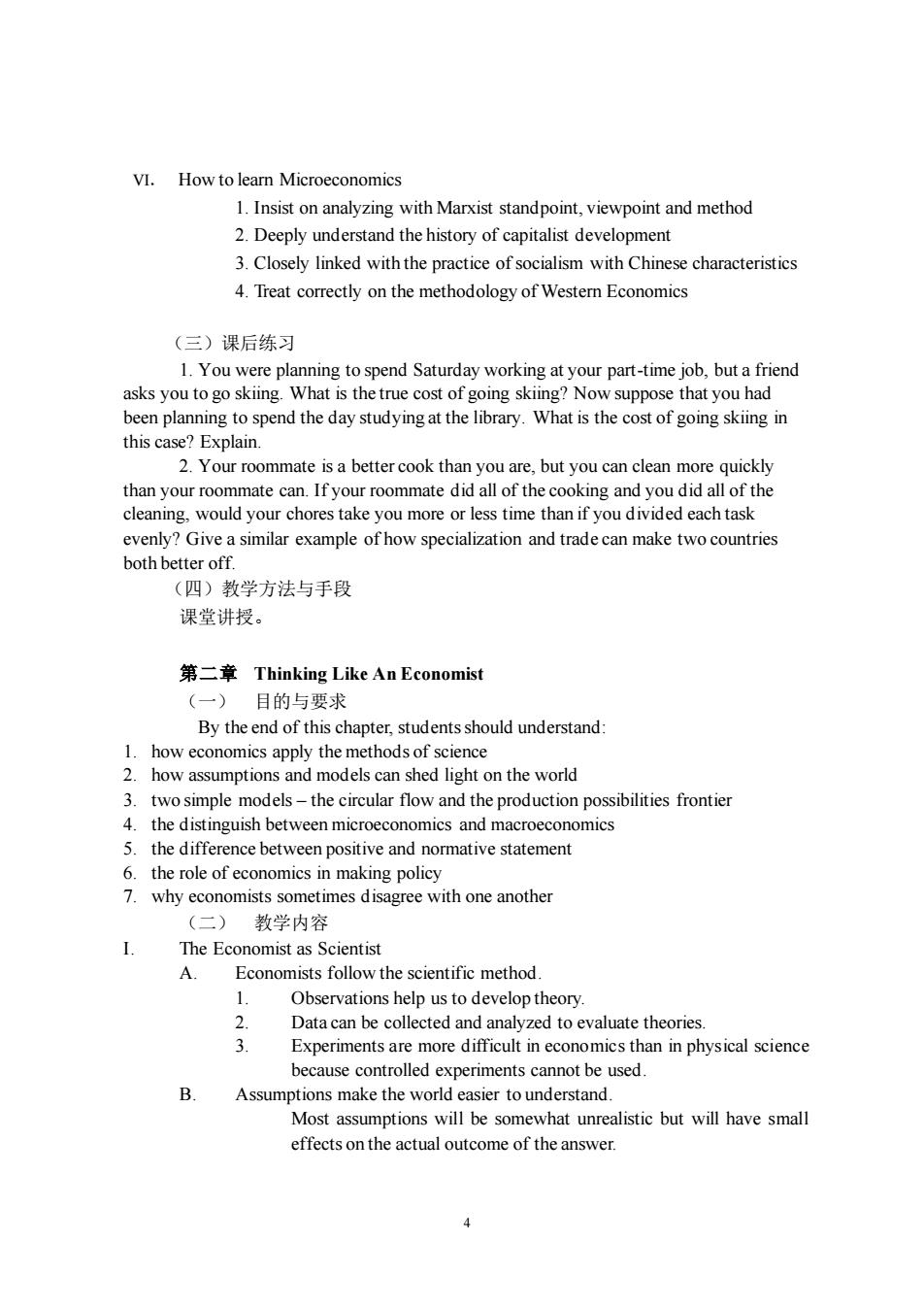正在加载图片...

VI.How to learn Microeconomics 1.Insist on analyzing with Marxist standpoint,viewpoint and method 2.Deeply understand the history of capitalist development 3.Closely linked with the practice of socialism with Chinese characteristics 4 Treat correctly on the methodology of Western economics (三)课后练习 1.You were planning to spend Saturday working at your part-time job,but a friend asks you to go sking.What t is the true cost of g ing ski suppo se that u had been planning to spend the day studying at the library.What is the cost of going skiing in this case?Explain. 2 Your roommate is a better cook than you are.but you can clean more quickly than your roommate can.If your roommate did all of the cooking and you did all of the cleaning.would your chores take you more or less time than ify evenly?Give a similar example of how specialization and trade can make two countrie both better off. (四)教学方法与手段 课堂讲授。 第二章Thinking Like An Economist (一)目的与要求 By the end of this chapter,students should understand 1.how economics apply the methods of science 2.how assumptions and models can shed light on the world 3.two simple models-the circular flow and the production possibilities frontier 4.the distinguish between microeconomics and macroeconomics 5.the difference betwee ve and normative statement 6.theroe of econmics in making policy 7.why economists sometimes disagree with one another (二)教学内容 The Economist as Scientist A. Economists follow the scientific method 1. Observations help us to develop theory. 2 data can be collected and analyzed to evaluate theories Experiments are more difficult in economics than in physical science becaus ontrolled ments ca not be used. easier to understand Most assumptions will be somewhat unrealistic but will have small effects on the actual outcome of the answer. 44 VI. How to learn Microeconomics 1. Insist on analyzing with Marxist standpoint, viewpoint and method 2. Deeply understand the history of capitalist development 3. Closely linked with the practice of socialism with Chinese characteristics 4. Treat correctly on the methodology of Western Economics (三)课后练习 1. You were planning to spend Saturday working at your part-time job, but a friend asks you to go skiing. What is the true cost of going skiing? Now suppose that you had been planning to spend the day studying at the library. What is the cost of going skiing in this case? Explain. 2. Your roommate is a better cook than you are, but you can clean more quickly than your roommate can. If your roommate did all of the cooking and you did all of the cleaning, would your chores take you more or less time than if you divided each task evenly? Give a similar example of how specialization and trade can make two countries both better off. (四)教学方法与手段 课堂讲授。 第二章 Thinking Like An Economist (一) 目的与要求 By the end of this chapter, students should understand: 1. how economics apply the methods of science 2. how assumptions and models can shed light on the world 3. two simple models – the circular flow and the production possibilities frontier 4. the distinguish between microeconomics and macroeconomics 5. the difference between positive and normative statement 6. the role of economics in making policy 7. why economists sometimes disagree with one another (二) 教学内容 I. The Economist as Scientist A. Economists follow the scientific method. 1. Observations help us to develop theory. 2. Data can be collected and analyzed to evaluate theories. 3. Experiments are more difficult in economics than in physical science because controlled experiments cannot be used. B. Assumptions make the world easier to understand. Most assumptions will be somewhat unrealistic but will have small effects on the actual outcome of the answer